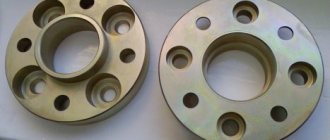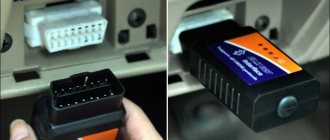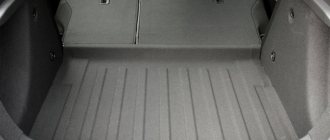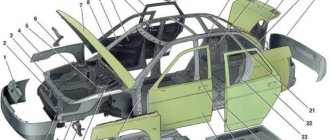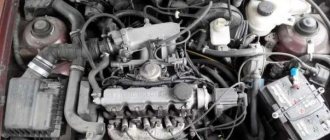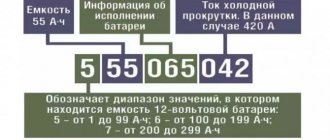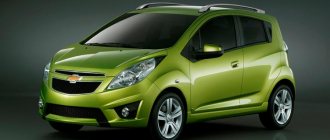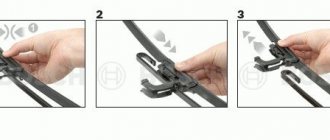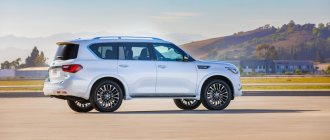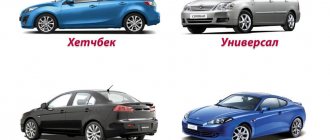In this article we will look at the main technical characteristics of the model, and you will also find out how much the VAZ-2114 weighs.
Technical specifications include:
- Aerodynamics.
- Dimensions.
- Clearance.
- Vehicle weight.
- Suspension features.
- Body information.
- Transmission.
- Engine performance.
DIFFERENCES between VAZ and VAZ 2109
Since the fourteenth, in fact, is a modified version of the nine, it is necessary to understand what the main difference between the VAZ 2109 and the VAZ 2114 is.
Let's go through the most significant points.
- Body
In terms of dimensions, the fourteenth differs slightly from the nine - it is 10 centimeters longer and 40 kg heavier. The ground clearance and wheelbase have not undergone any changes.
The differences in the body are quite significant - the presence of a new hood, headlights, radiator, bumpers and moldings create the impression of a completely new car. If we talk about the quality of the metal, then things are much better in the fourteenth model - with proper care, it does not rot even in the most problematic places.
- Engine and suspension
The base model of the VAZ 2114 was equipped with an 8-valve 1500 cm3 engine, similar to the one on the Nine, but in 2007 models with a 1.6-liter engine that complied with the Euro-4 standard with an electronic gas pedal and an electric throttle began to roll off the assembly line.
In 2010, the “Super-Auto” modification went on sale with a 16-valve power unit, which is superior to the Nine engine in all respects.
The chassis of the fourteenth, in comparison with the VAZ 2109, did not undergo any serious design changes.
- Salon
The interior is one of the key advantages of the fourteenth in comparison with the VAZ 2109. The first thing that stands out (thanks to the use of hard plastic), whereas in the nineth, this was one of the main problems.
Specially invited foreign designers worked on creating the interior of the cabin, so it is visually comparable to the interior of middle-class foreign cars of the same year of manufacture.
Unlike the Nine, the interior of the VAZ 2114 is distinguished by softer shapes and the presence of various little things - power windows, new seats, illuminated ashtrays, which significantly improve the comfort of both the driver and front passenger.
The functionality of the interior has also improved significantly - the instrument panel is equipped with an on-board computer, which informs the driver about the status of the main vehicle systems, ambient temperature, current time and has many useful functions.
2114 and 2109
Control points of car body geometry
Most control points are holes in structural elements of the body. In general, any stationary points on the structural elements of the body can act as control points. You can measure, for example, between symmetrical angles.
Control points are located in vertical or horizontal planes. Their locations vary depending on the car model. Repair manuals indicate the location of specific points and the distances between them.
Measurements are made between the centers of the control holes or between their edges.
Usually the distances are measured from center to center of these holes located on opposite sides of the car. Test point holes typically have a larger diameter than the ends of the ruler. In this case, you need to measure from edge to edge of the holes.
If necessary, the attachment points of the suspension elements are measured, as they affect the wheel alignment. You can also measure the position of the wheels.
In case of emergency deformation, control points can be used to determine the central plane of the machine, based on its undamaged part. Next, the central plane will help to find out the degree of deviation of the damaged part or the correctness of the repair.
When using a measuring ruler, it is advisable to have information about the factory parameters of the distances between control points. When checking these parameters, you need to take into account what distances are indicated (from center to center or from edge to edge). If there is no information about the factory geometric parameters of the body, then you can use an undamaged car of the same model to compare distances. A comparative measurement of the opposite, undamaged part is also used.
FEATURES AND 16 VALVE MODELS
The 2114 model range is represented by two factory modifications: the classic “Samara”, which was produced from 2001 to 2013, and “Super-Auto”, produced by a VAZ subsidiary - Super-Avto CJSC, the supply of which to the market began in 2010 and continue to this day.
These modifications differ in their power unit: the “Samara” has an engine with 8 valves, the “Super-Auto” has an engine with 16 valves, which is equipped as stock in the “Lada Priora”.
Visually determining which engine is installed on the fourteenth is only possible for professionals, or those who are well versed in the VAZ model range, since externally they have only one difference - wheel rims of different diameters: the 8v has thirteen-inch wheels, the 16v has fourteen-inch wheels.
All the main differences lie in the power units, which are similar in only one way - displacement; both models have 1.6-liter engines.
Let's go over the main advantages of the model with a 16v engine:
- The maximum power of the 16v engine is 66 kW, which provides 5000 rpm, while the 8v 60 kW engine produces 5200 rpm;
- If we translate these characteristics into horsepower, then in 16v – 90 horses, and in 8v – 81;
- In addition, in the 16v power unit, the combustion efficiency of the fuel mixture has been significantly improved; in the 16-valve 14th, the consumption per 100 km is 7 liters, in the 8v model – 7.6 l/100km;
- The 16v engine also has the best torque (Nm) - 131/3700 min, for the 8v - 120/2700 min, which is why the acceleration performance of the sixteen valve engine is much superior to the 8v - 11.2 and 13.2 seconds to hundreds, respectively;
- Maximum speed 16v – 190 km/h, 8v – 160 km/h.
The increased power of the 16v power unit was the reason for modifications to the brake system of the fourteenth: the new VAZ 2114 models are equipped with 14-inch brake discs with a ventilating cavity, the presence of which eliminates the possibility of overheating of the brake pads during emergency braking.
It is also worth noting that the VAZ 2114 with a 16v engine holds the roadway much more confidently due to the improved suspension - the car is equipped with energy-intensive shock absorbers and improved struts.
This concludes the review of the fourteenth.
Angle of longitudinal inclination of the axis of rotation
Caster angle is a parameter that is unique to front suspensions. He is responsible for the car's handling during sharp turns.
Essentially, this is the angle that characterizes the tilt of the steering axis of the wheel back and forth.
Caster angle can be positive, negative or zero.
On sports cars, the caster angle can reach seven degrees. The main reason for the deviation is the failure (deformation) of the lower wishbone.
Thanks to the caster angle, the steering wheel returns to its original position (if the parameter is correctly adjusted).
On conventional cars, the pitch angle is positive (for example, in the Mitsubishi Outlander XL this parameter is 2.35 degrees).
Exterior changes
The interior was updated with a European dashboard, an adjustable steering wheel and a completely new heating system. The rear seats can be folded down to create a larger trunk if needed.
Additionally, the VAZ-2114 is equipped with the following options:
- Electric windows.
- Heated seats.
- Central locking.
- Factory tinting in accordance with GOST requirements.
- The sills have fairings and moldings.
- Alloy wheels.
- Fog lights.
The maximum configuration of cars comes with an on-board computer that displays the following information:
- Average driving speed.
- Gasoline consumption.
- Travel time.
- Outside air temperature.
- Vehicle electrical network voltage and many other parameters.
Removing and replacing side lamps in the rear light
The replacement process involves sequentially performing the following steps:
- the trunk opens;
- to gain access to the headlight, remove the carpet covering it from the inside;
- the board contacts are disconnected;
- the bar is removed (all the rear light bulbs are on it).
Replaced with a new side light bulb (the side light bulbs on the VAZ 2114 have the smallest size, so it will be difficult to confuse them); The board with the new light bulb is installed in its original place.
If replacing the light bulb in the front/rear marker does not produce results and the side lights still do not work, then you need to check the appropriate fuses or look for other causes of the malfunction.
Dimensions, dimensions, weight kg.
| Options | Dimensions | Weight, kg |
| 1.5 MT Basic | 4122 x 1650 x 1402 | 985 |
| 1.6 MT Basic | 4122 x 1650 x 1402 | 985 |
| 1.6MT0 | 4122 x 1650 x 1402 | 985 |
| 1.6MT0 | 4122 x 1650 x 1402 | 985 |
| 1.6MT0 | 4122 x 1650 x 1402 | 985 |
| 1.6MT2 | 4122 x 1650 x 1402 | 985 |
| 1.6MT0 | 4122 x 1650 x 1402 | 985 |
| 1.6 MT 211440-24 | 4122 x 1650 x 1402 | 985 |
| 1.6 MT 211440-26 | 4122 x 1650 x 1402 | 985 |
| 1.6MT0 | 4122 x 1650 x 1402 | 1060 |
| 1.6MT2 | 4122 x 1650 x 1402 | 1060 |
| 1.6MT0 | 4122 x 1650 x 1402 | 1060 |
| 1.6MT1 | 4122 x 1650 x 1402 | 1060 |
This is interesting: How much does the body of a VAZ 2101 weigh?
In normal condition
In the luggage compartment of the VAZ 2114 there is enough space to transport a variety of cargo of varying weights. If necessary, the volume can be increased by folding the seats or using additional features. The minimum trunk volume of the Lada 2114 is 330 liters. If you have bulky cargo of varying weights, you can additionally use special fastenings for transporting things on the roof. The luggage compartment has the following dimensions with the seats folded down:
- The length is 830 mm.
- The width is 935 mm.
- Height 400 mm.
The disadvantage is the large loading height. The owner of the car can carry out tuning by installing a push-button opening and closing mechanism. You can carry out this procedure yourself or contact a specialist for this. After installing such a mechanism, the driver will be able to open the door without getting up. To do this, just press a button on the remote control. This is more convenient than using a key for this purpose.
For example, this is important if ice is frozen in the area of the castle. When transporting things, the requirements for their dimensions and weight are determined by traffic rules
It is allowed not only to transport those that fit completely, but also those that protrude without violating traffic rules. It is important to ensure that the load, regardless of its weight, is securely secured.
How many seats
| Options | Number of seats |
| 1.5 MT Basic | 5 |
| 1.6 MT Basic | 5 |
| 1.6MT0 | 5 |
| 1.6MT0 | 5 |
| 1.6MT0 | 5 |
| 1.6MT2 | 5 |
| 1.6MT0 | 5 |
| 1.6MT0 | 5 |
| 1.6MT2 | 5 |
| 1.6MT0 | 5 |
| 1.6MT1 | 5 |
| 1.6 MT 211440-24 | 5 |
| 1.6 MT 211440-26 | 5 |
Should I choose stamped or cast wheels?
All types of wheel rims have their advantages and disadvantages:
Stamped. Due to ease of production they have minimal cost. In case of damage, dents are easily removed. They are heavy and require careful balancing;
- Cast. Manufactured by casting from aluminum alloys. Due to their low weight, they reduce the load on the hub assembly by reducing the unsprung mass. Easy to balance. They are almost impossible to straighten when deformed, and due to their low strength they are susceptible to chips and cracks, which can only be eliminated by argon welding.
- Forged. These are the same cast ones, only additionally strengthened by forging. With the same advantages as cast ones, they have much higher strength. Due to the complexity of manufacturing technologies, they have a high cost (R14/4×98 will cost at least 25,000 rubles).
If you plan to drive exclusively on smooth asphalt, then the best option is alloy wheels, which in appearance are practically no different from forged ones. When traveling over rough terrain, you should choose stamped wheels, since nicks can be removed on the road using an ordinary hammer. In addition, the VAZ 2114 on stamped R13 wheels looks quite stylish. Many car owners prefer swamp stamps.
Trunk volume
| Options | Trunk capacity, l |
| 1.5 MT Basic | 427 |
| 1.6 MT Basic | 427 |
| 1.6MT0 | 427 |
| 1.6MT0 | 427 |
| 1.6MT0 | 427 |
| 1.6MT2 | 427 |
| 1.6MT0 | 427 |
| 1.6MT0 | 427 |
| 1.6MT2 | 427 |
| 1.6MT0 | 427 |
| 1.6MT1 | 427 |
| 1.6 MT 211440-24 | 427 |
| 1.6 MT 211440-26 | 427 |
Drive unit
| Options | type of drive |
| 1.5 MT Basic | Front (FF) |
| 1.6 MT Basic | Front (FF) |
| 1.6MT0 | Front (FF) |
| 1.6MT0 | Front (FF) |
| 1.6MT0 | Front (FF) |
| 1.6MT2 | Front (FF) |
| 1.6MT0 | Front (FF) |
| 1.6MT0 | Front (FF) |
| 1.6MT2 | Front (FF) |
| 1.6MT0 | Front (FF) |
| 1.6MT1 | Front (FF) |
| 1.6 MT 211440-24 | Front (FF) |
| 1.6 MT 211440-26 | Front (FF) |
Ruler for measuring the geometry of a car body
The folding ruler is the most commonly used measuring device for measuring body geometry.
p, blockquote 14,0,0,0,0 —>
p, blockquote 15,0,0,0,0 —>
A measuring ruler is capable of measuring the distance between two points. Each distance must be cross-checked with two additional control points.
p, blockquote 16,0,0,0,0 —>
A modern ruler for measuring body geometry is a telescopic measuring device with height-adjustable pointers. Even when unfolded to its full length, it does not cause measurement errors. Depending on the type of ruler used, additional measurement may be required between the pointers. Additional accessories in the line include attachments and extensions for tight placement in inspection holes.
p, blockquote 17,0,0,0,0 —>
The ruler allows you to take measurements when there are obstacles between the measured points.
p, blockquote 18,0,0,0,0 —>
All cars are symmetrical about an imaginary central plane located along the center of the car. However, there are a few points on some cars that, for various reasons, are not symmetrical, but they do not make the entire car asymmetrical. Without symmetry, a car would be very difficult to make and even to sell.
p, blockquote 19,0,0,0,0 —>
It is important that the indicators are firmly inserted into the inspection holes.
p, blockquote 20,0,0,0,0 —>
As mentioned earlier, if the pointers were set to different heights, then the value on the ruler scale may differ from the actual distance between the points being measured. For the correct value, you need to additionally measure the distance between the indicators with a tape measure.
p, blockquote 21,0,0,0,0 —>
The ruler and pointers must be straight. The indicators should be positioned 90 degrees relative to the ruler and have no play.
p, blockquote 22,1,0,0,0 —>
It is important that when measuring, the length of the indicators is set at the same distance.
p, blockquote 23,0,0,0,0 —>
p, blockquote 24,0,0,0,0 —>
If you do not need to obtain exact values when measuring, but compare one side to the other, then the ruler does not have to be parallel to the plane of the machine. You can compare distances with the opposite side, as well as with similar points on the same whole vehicle (comparative measurement).
Clearance
| Options | Ground clearance, mm |
| 1.5 MT Basic | 165 |
| 1.6 MT Basic | 165 |
| 1.6MT0 | 165 |
| 1.6MT0 | 165 |
| 1.6MT0 | 165 |
| 1.6MT2 | 165 |
| 1.6MT0 | 165 |
| 1.6MT0 | 165 |
| 1.6MT2 | 165 |
| 1.6MT0 | 165 |
| 1.6MT1 | 165 |
| 1.6 MT 211440-24 | 165 |
| 1.6 MT 211440-26 | 165 |
Fuel consumption
| Modification | Fuel consumption, l/100 km | Fuel used |
| 1.6 l, 98 hp, gasoline, manual transmission, front-wheel drive | 7,2 | Gasoline AI-95 |
| 1.5 l, 77 hp, gasoline, manual transmission, front-wheel drive | 7,3 | Gasoline AI-95 |
| 1.6 l, 89 hp, gasoline, manual transmission, front-wheel drive | 7,4 | Gasoline AI-95 |
| 1.6 l, 82 hp, gasoline, manual transmission, front-wheel drive | 7,6 | Gasoline AI-95 |
| 1.6 l, 81 hp, gasoline, manual transmission, front-wheel drive | 7,8 | Gasoline AI-95 |
Competitors
The VAZ 2114 has had many competitors at all times, and many drivers were amazed: why, with such a variety of foreign analogues, many car enthusiasts prefer the domestic “designer”. It's simple: getting spare parts for foreign cars was often problematic. You can repair a VAZ using improvised means. However, among the competitive models, several cars should be highlighted. The first of them is the Chevrolet Lacetti. This nimble and attractive car has excellent dynamic characteristics, great endurance and rich technical equipment. Its design, developed by the Italian studio Pininfarina in 2002, is still relevant today. The car, discontinued in 2014, is still in high demand on the secondary market.
Chevrolet Lacetti
The Opel Corsa is another compact car, famous for its high engine life and excellent handling. From the outside it seems that the Corsa is cramped and uncomfortable, but when you look into the interior, you are pleasantly surprised - everything here is laconic and thoughtful. The history of the Opel Corsa began in 1982 and continues to this day. In the line of its generations one can trace the history of improving engineering. The manufacturer switched from broken lines to exaggerated futuristic design back in 2000, a year later AvtoVAZ released the “square fourteenth”. In 2006, an updated version of the Corsa was born - with huge headlights, stylish moldings in the front part and an elegant body bevel. In the VAZ 2114, in addition to engine modifications, there were no more significant changes until the end of production.
Volume of the tank
| Options | Fuel tank volume, l |
| 1.5 MT Basic | 43 |
| 1.6 MT Basic | 43 |
| 1.6MT0 | 43 |
| 1.6MT0 | 43 |
| 1.6MT0 | 43 |
| 1.6MT2 | 43 |
| 1.6MT0 | 43 |
| 1.6MT0 | 43 |
| 1.6MT2 | 43 |
| 1.6MT0 | 43 |
| 1.6MT1 | 43 |
| 1.6 MT 211440-24 | 43 |
| 1.6 MT 211440-26 | 43 |
